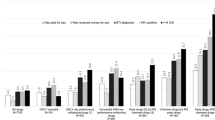Abstract
The HIV epidemic that began in Russia in the mid-1990s has been concentrated mostly among drug users (DUs). Recent evidence of increasing HIV cases among non-DUs attributed to sexual behavior raises potential concern about a more generalized epidemic. The purpose of this analysis is to examine the potential for HIV transmission from DUs to their non-DU sex partners. Analyses are conducted using data collected during 2005–2008 in St. Petersburg, Russia. A total of 631 DUs were recruited into the sample with an HIV prevalence of 45%. A majority (84%) of DUs reported being sexually active in the past 6 months, and the DU status of their sex partners was reported as follows: 54% DU, 40% non-DU, and 6% unknown DU status. In 41% of partnerships with an HIV-negative or unknown status partner not known to be DU (potential bridging partnerships), the last reported intercourse was unprotected. Female DUs with potential bridging partnerships were more likely than male DUs to be younger and report homelessness and to have multiple or new sex partners. Many non-DU sex partners of DUs enrolled in the study reported new sex partners in the past 6 months (66%), unprotected intercourse at last sex (60%), and multiple sex partners in the past 6 months (48%). HIV prevalence in this group was 15% (eight out of 53). The high prevalence of HIV among DUs, their sexual contact with non-DUs, and the high-risk sexual behaviors of this potential bridging population together indicate the real potential for an increasingly generalized epidemic. The degree to which there will be further transmission from non-DU sex partners of DUs who exhibit high levels of sex risk behaviors to other non-DU sex partners deserves further study.

Similar content being viewed by others
References
AIDS Foundation East–West. Officially registered HIV cases in Russian Federation 1 January 1987–31 July 2008 as reported by the Russian Federal AIDS Center. http://www.afew.org. Accessed 22 November 2008.
World Health Organization. Epidemiologic Fact Sheet 2006 Russian Federation; 2006.
Rhodes T, Sarang A, Bobrik A, Bobkov A, Platt L. HIV transmission and HIV prevention associated with injecting drug use in the Russian Federation. Int J Drug Pol. 2004; 15: 1–16.
Rhodes T, Platt L, Maximova S, et al. Prevalence of HIV, hepatitis C and syphilis among injecting drug users in Russia: A multi-city study. Addiction. 2006; 101: 252–266.
Niccolai LM, Toussova OV, Verevochkin SV, Barbour R, Heimer R, Kozlov AP. High HIV prevalence, suboptimal HIV testing, and low knowledge of HIV-positive serostatus among injection drug users in St. Petersburg Russia. AIDS Behav. 2008. doi:10.1007/s10461-008-9469-y.
Rhodes T, Lowndes CM, Judd A, et al. Explosive spread and high prevalence of HIV infection among injecting drug users in Togliatti City, Russia. AIDS. 2002; 16: F25–F31.
Russian Health Ministry’s AIDS Prevention and Treatment Center reported by Kaiser Daily HIV/AIDS Report; 2004.
Rakhmanova A, Vinogradova E, Yakovlev A. The Characteristics of HIV-Infection in St. Petersburg. St. Petersburg, RF: City Health Committee; 2007.
Centers for Disease Control and Prevention. Rapid increase in HIV rates—Orel Oblast: Russian Federation, 1999–2001. MMWR. 2003; 52: 657–660.
Lowndes CM, Renton A, Alary M, Rhodes T, Garnett G, Stimson G. Conditions for widespread heterosexual spread of HIV in the Russian Federation: Implications for research, monitoring and prevention. Int J Drug Pol. 2003; 14: 45–62.
Burchell AN, Calzavara LM, Orekhovsky V, Ladnaya NN. Characterization of an emerging heterosexual HIV epidemic in Russia. Sex Transm Dis. 2008; 35: 807–813.
Acknowledgments
This work was supported by NIH grants 5U01DA017387 (National Institute of Drug Abuse, PI), 5P30NIMH62294 (National Institute Mental Health), and 5D43TW001028 (Fogarty International Center) to Yale University.
Author information
Authors and Affiliations
Corresponding author
Rights and permissions
About this article
Cite this article
Niccolai, L.M., Shcherbakova, I.S., Toussova, O.V. et al. The Potential for Bridging of HIV Transmission in the Russian Federation: Sex Risk Behaviors and HIV Prevalence among Drug Users (DUs) and their Non-DU Sex Partners. J Urban Health 86 (Suppl 1), 131–143 (2009). https://doi.org/10.1007/s11524-009-9369-0
Received:
Accepted:
Published:
Issue Date:
DOI: https://doi.org/10.1007/s11524-009-9369-0



